Girsu
Girsu (Sumerian Ĝirsu;[1] cuneiform ĝir2-suki 𒄈𒋢𒆠) was a city of ancient Sumer, situated some 25 km (16 mi) northwest of Lagash, at the site of modern Tell Telloh, Dhi Qar Governorate, Iraq.
.jpg) Archaeological remains of constructions at Tello/ Girsu. | |
 Shown within Near East  Girsu (Iraq) | |
| Location | Tell Telloh, Dhi Qar Province, Iraq |
|---|---|
| Region | Sumer |
| Coordinates | 31°33′43.3″N 46°10′39.3″E |
| Type | Settlement |
History

Girsu was possibly inhabited in the Ubaid period (5300-4800 BC), but significant levels of activity began in the Early Dynastic period (2900-2335 BC). At the time of Gudea, during the Second Dynasty of Lagash, Girsu became the capital of the Lagash kingdom and continued to be its religious center after political power had shifted to city of Lagash.[3] During the Ur III period, Girsu was a major administrative center for the empire. After the fall of Ur, Girsu declined in importance, but remained inhabited until approximately 200 BC.
Archaeology
Telloh was the first Sumerian site to be extensively excavated, at first under the French vice-consul at Basra, Ernest de Sarzec, from 1877 to 1900, followed by his successor Gaston Cros from 1903–1909.[4][5] Excavations continued under Abbé Henri de Genouillac in 1929–1931 and under André Parrot in 1931–1933.[6][7][8] It was at Girsu that the fragments of the Stele of the Vultures were found. The site has suffered from poor excavation standards and also from illegal excavations. About 50,000 cuneiform tablets have been recovered from the site.[9] Excavations at Tello have now resumed as part of a training program for Iraqi archaeologists organized by the American Schools of Oriental Research.[10] A foundation tablet and a number of inscribed building cones have been found. In March 2020, archaeologists announced the discovery of a 5,000-year-old cultic area filled with animal sacrifices and ritual processions dedicated to Ningirsu.[11]
Gallery
Ubaid IV artifacts (4700–4200 BC) in Girsu
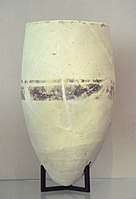 Ubaid IV pottery gobelet, 4700–4200 BC Tello, ancient Girsu. Louvre Museum.[12]
Ubaid IV pottery gobelet, 4700–4200 BC Tello, ancient Girsu. Louvre Museum.[12] Ubaid IV pottery jars 4700–4200 BC Tello, ancient Girsu, Louvre Museum.[13]
Ubaid IV pottery jars 4700–4200 BC Tello, ancient Girsu, Louvre Museum.[13]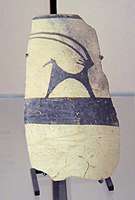 Ubaid IV pottery 4700–4200 BC Tello, ancient Girsu, Louvre Museum AO 15338.[14]
Ubaid IV pottery 4700–4200 BC Tello, ancient Girsu, Louvre Museum AO 15338.[14]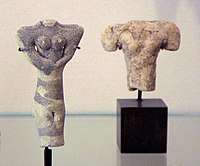 Female figurines Ubaid IV, Tello, ancient Girsu, 4700–4200 BC. Louvre Museum AO15327.[15]
Female figurines Ubaid IV, Tello, ancient Girsu, 4700–4200 BC. Louvre Museum AO15327.[15]
Uruk Period artifacts (4000–3100)
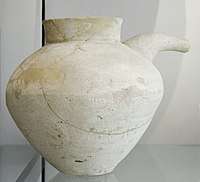 Uruk period vase. Terracotta, ca. 3500–2900 BC. From Telloh, ancient city of Girsu. Louvre Museum.
Uruk period vase. Terracotta, ca. 3500–2900 BC. From Telloh, ancient city of Girsu. Louvre Museum. Vase. Terracotta with red slip, ca. 3500–2900 BC. From Telloh, ancient city of Girsu. Louvre Museum.
Vase. Terracotta with red slip, ca. 3500–2900 BC. From Telloh, ancient city of Girsu. Louvre Museum. Vase. Terracotta, ca. 3500–2900 BC. From Telloh, ancient city of Girsu.
Vase. Terracotta, ca. 3500–2900 BC. From Telloh, ancient city of Girsu.
Early dynastic artifacts in Girsu (3rd millennium BC)
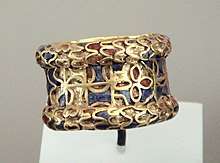 Ring of Gold, Carnelian, Lapis Lazuli, Tello, ancient Girsu, mid-3rd millennium BC. Louvre Museum.
Ring of Gold, Carnelian, Lapis Lazuli, Tello, ancient Girsu, mid-3rd millennium BC. Louvre Museum.- An account of barley rations issued monthly to adults and children written in Cuneiform on clay tablet, written in year 4 of King Urukagina (circa 2350 BC). From Girsu, Iraq. British Museum, London.
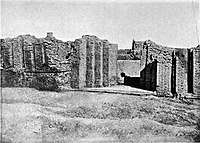 Telloh doorway erected by Gudea (c. 2100 BC)
Telloh doorway erected by Gudea (c. 2100 BC)
See also
| Wikimedia Commons has media related to Girsu. |
- Gudea cylinders
- Ningirsu
- Statues of Gudea
- Short chronology timeline
- Cities of the ancient Near East
Notes
- Because of the initial nasal velar ŋ, the transcription of Ĝirsu is sometimes spelled as Ngirsu (also: G̃irsu, Girsu, Jirsu).
- "Site officiel du musée du Louvre". cartelfr.louvre.fr.
- Dietz Otto Edzard, Gudea and His Dynasty. University of Toronto Press, 1997, ISBN 0-8020-4187-6
- Découvertes en Chaldée, E. de Sarzec, Paris, Leroux, 1884–1893
- Nouvelles fouilles de Tello, Gaston Cros, Paris, 1910
- Fouilles de Telloh I: Epoques presargoniques, Abbé Henri de Genouillac, Paris, 1934
- Fouilles de Telloh II: Epoques d'Ur III Dynastie et de Larsa, Abbé Henri de Genouillac, Paris, 1936
- A. Parrot, Tello: vingt campagnes de fouilles 1877–1933, Paris, A. Michel ,1948
- Telloh Tablets at Haverford Library
- The Iraq Emergency Heritage Management Training Scheme
- "Ancient cultic area for warrior-god uncovered in Iraq". Live Science. 31 March 2020.
- "Site officiel du musée du Louvre". cartelfr.louvre.fr.
- "Site officiel du musée du Louvre". cartelfr.louvre.fr.
- "Site officiel du musée du Louvre". cartelfr.louvre.fr.
- "Figurine féminine d'Obeid". 2019.
- Marshall, John (1996). Mohenjo-Daro and the Indus Civilization: Being an Official Account of Archaeological Excavations at Mohenjo-Daro Carried Out by the Government of India Between the Years 1922 and 1927. Asian Educational Services. pp. 425–426. ISBN 9788120611795.
- THUREAU-DANGIN, F. (1925). "SCEAUX DE TELLO ET SCEAUX DE HARAPPA". Revue d'Assyriologie et d'Archéologie Orientale. 22 (3): 99–101. JSTOR 23283916.
Further reading
- Harriet Crawford, The Construction Inférieure at Tello. A Reassessment, Iraq, vol. 49, pp. 71–76, 1987
- Benjamin R. Foster, The Sargonic Victory Stele from Telloh, Iraq, Vol. 47, pp. 15–30, 1985
- Claudia E. Suter, A Shulgi Statuette from Tello, Journal of Cuneiform Studies, vol. 43/45, pp. 63–70, (1991–1993)
External links
- Fragment of a stone plaque depicting Enannatum found in Tello (Girsu), from the collection of the British Museum, on the site of Google Cultural Institute
- Images of Girsu - Oriental Institute of the University of Chicago
- Stele of the Vultures at the Louvre
- The world's oldest bridge is being preserved in Iraq
- The Iraq Emergency Heritage Management Training Scheme: an update